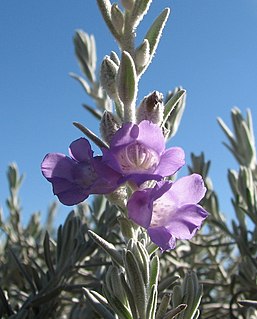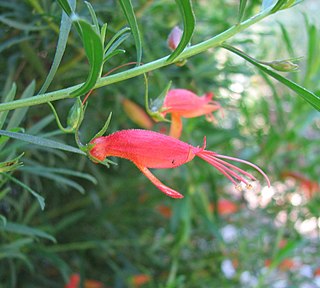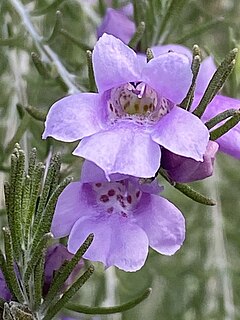
Eremophila oldfieldii, commonly known as pixie bush, is a flowering plant in the figwort family, Scrophulariaceae and is endemic to Western Australia. It is a shrub or small tree with rough bark, broad, flat or narrow fleshy leaves and red, orange or yellow flowers.

Eremophila nivea, commonly known as silky eremophila, is a flowering plant in the figwort family, Scrophulariaceae and is endemic to Western Australia. In nature it is a rare shrub with hairy branches and leaves, and blue, purple or violet flowers.

Eremophila decipiens, commonly known as slender fuchsia bush or narrow-leaved fuchsia bush is a flowering plant in the figwort family, Scrophulariaceae and is endemic to an area extending from the south-west of Western Australia to southern parts of South Australia. It is low, sprawling shrub with lance-shaped leaves and red, orange or yellow flowers on a long, S-shaped stalk.

Eremophila microtheca, also known as heath-like eremophila, is a flowering plant in the figwort family, Scrophulariaceae and is endemic to Western Australia. It is an erect shrub with densely hairy branches and leaves, narrow leaves and pale lilac-coloured flowers and which emits a strong odour.

Eremophila densifolia is a flowering plant in the figwort family, Scrophulariaceae and is endemic to the south-west of Western Australia. It is usually a low, spreading shrub with densely clustered leaves and lilac to purple flowers.

Eremophila foliosissima, commonly known as poverty bush, is a flowering plant in the figwort family, Scrophulariaceae and is endemic to Western Australia. It is a small, erect, densely foliaged shrub with long, narrow, hairy leaves and mauve to purple flowers. It is similar to Eremophila gilesii but is more dense and rounded, has more crowded leaves and has different hairs on the flowers.
Eremophila grandiflora is a flowering plant in the figwort family, Scrophulariaceae and is endemic to Western Australia. It is a large shrub with shiny leaves and the largest flowers in its genus and is only known from a restricted area near Paynes Find.
Eremophila petrophila is a flowering plant in the figwort family, Scrophulariaceae and is endemic to Western Australia. It is a tall, erect, open shrub with rough branches, narrow, sticky leaves and pale lilac-coloured flowers.
Eremophila phillipsii is a flowering plant in the figwort family, Scrophulariaceae and is endemic to Western Australia. It is a tall, erect, open shrub, with narrow leaves and lilac to purple flowers which are white with purple spots inside. It often has an offensive smell.
Eremophila simulans is a flowering plant in the figwort family, Scrophulariaceae and is endemic to Western Australia. It is an erect shrub with broad, serrated leaves and violet to purple flowers.

Eremophila spectabilis, commonly known as showy poverty bush, is a flowering plant in the figwort family, Scrophulariaceae and is endemic to Western Australia. It is a dense, erect shrub with narrow, greyish leaves and blue, mauve or purple flowers.
Eremophila verticillata, commonly known as whorled eremophila, is a flowering plant in the figwort family, Scrophulariaceae and is endemic to Western Australia. It is a low, spreading or rounded shrub with a strong odour, small leaves pressed against the stem and purple flowers. It is a rare plant, partly due to land clearing.

Eremophila willsii is a flowering plant in the figwort family, Scrophulariaceae and is endemic to Australia. It is an erect shrub with bright green, often serrated leaves and pinkish to deep pinkish-purple petals. It is mainly found in Western Australia, the Northern Territory and South Australia in deep sand.
Eremophila buirchellii is a flowering plant in the figwort family, Scrophulariaceae and is endemic to the Mount Augustus National Park in Western Australia. It is an erect shrub with densely clustered leaves, pink, bell-shaped flowers and with most parts of the plant covered with greyish, branched hairs.
Eremophila calcicola is a flowering plant in the figwort family, Scrophulariaceae and is endemic to a small area in the south of Western Australia. It is a low, spreading, short-lived shrub with broad leaves, and pale, greenish-yellow flowers over a long period.
Eremophila ballythunnensis is a flowering plant in the figwort family, Scrophulariaceae and is endemic to Western Australia. It is a small, spreading shrub with narrow oval leaves and mauve-purple flowers with densely hairy sepals.
Eremophila capricornica is a flowering plant in the figwort family, Scrophulariaceae and is endemic to Western Australia. It is a small shrub with woolly branches, grey, hairy leaves and mauve to lilac-coloured flowers with hairy sepals.
Eremophila ferricola is a flowering plant in the figwort family, Scrophulariaceae and is endemic to Western Australia. It is an erect shrub with lance-shaped leaves and yellowish brown to greenish yellow flowers covered with fine hairs. The species is only known from a single location, growing on a banded ironstone hill.
Eremophila jamesiorum is a flowering plant in the figwort family, Scrophulariaceae and is endemic to Western Australia. It is a wispy, sticky shrub with narrow linear leaves and white flowers tinged with pink or mauve. It is only known from a few locations in the Gibson Desert.
Eremophila yinnetharrensis is a species of flowering plant in the family Scrophulariaceae and is endemic to a restricted area of Western Australia. It is an erect, wispy shrub with sessile, lance-shaped leaves with the narrower end towards the base and purple flowers. It is only known from near Yinnetharra Station in the Gascoyne region.








